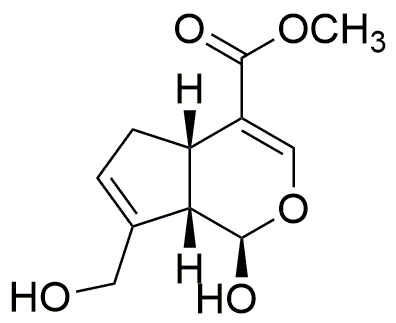Genipin is widely utilized in research focused on:
- Natural Dye Production: Genipin is extracted from the fruit of the gardenia plant and is used as a natural blue dye in textiles and food products, offering a safer alternative to synthetic dyes.
- Biomaterials: In the medical field, it serves as a crosslinking agent for creating biocompatible hydrogels, which are essential for tissue engineering and drug delivery systems.
- Antioxidant Properties: Genipin exhibits strong antioxidant effects, making it valuable in the formulation of dietary supplements and functional foods aimed at promoting health and preventing oxidative stress.
- Wound Healing: Its application in wound dressings is notable due to its ability to enhance healing processes, providing a natural solution for improving recovery times.
- Food Preservation: Genipin can be utilized in food products to inhibit spoilage and extend shelf life, offering a natural alternative to chemical preservatives.
General Information
Properties
Safety and Regulations
Applications
Genipin is widely utilized in research focused on:
- Natural Dye Production: Genipin is extracted from the fruit of the gardenia plant and is used as a natural blue dye in textiles and food products, offering a safer alternative to synthetic dyes.
- Biomaterials: In the medical field, it serves as a crosslinking agent for creating biocompatible hydrogels, which are essential for tissue engineering and drug delivery systems.
- Antioxidant Properties: Genipin exhibits strong antioxidant effects, making it valuable in the formulation of dietary supplements and functional foods aimed at promoting health and preventing oxidative stress.
- Wound Healing: Its application in wound dressings is notable due to its ability to enhance healing processes, providing a natural solution for improving recovery times.
- Food Preservation: Genipin can be utilized in food products to inhibit spoilage and extend shelf life, offering a natural alternative to chemical preservatives.
Documents
Safety Data Sheets (SDS)
The SDS provides comprehensive safety information on handling, storage, and disposal of the product.
Product Specification (PS)
The PS provides a comprehensive breakdown of the product’s properties, including chemical composition, physical state, purity, and storage requirements. It also details acceptable quality ranges and the product's intended applications.
Certificates of Analysis (COA)
Search for Certificates of Analysis (COA) by entering the products Lot Number. Lot and Batch Numbers can be found on a product’s label following the words ‘Lot’ or ‘Batch’.
*Catalog Number
*Lot Number
Certificates Of Origin (COO)
This COO confirms the country where the product was manufactured, and also details the materials and components used in it and whether it is derived from natural, synthetic, or other specific sources. This certificate may be required for customs, trade, and regulatory compliance.
*Catalog Number
*Lot Number
Safety Data Sheets (SDS)
The SDS provides comprehensive safety information on handling, storage, and disposal of the product.
DownloadProduct Specification (PS)
The PS provides a comprehensive breakdown of the product’s properties, including chemical composition, physical state, purity, and storage requirements. It also details acceptable quality ranges and the product's intended applications.
DownloadCertificates of Analysis (COA)
Search for Certificates of Analysis (COA) by entering the products Lot Number. Lot and Batch Numbers can be found on a product’s label following the words ‘Lot’ or ‘Batch’.
*Catalog Number
*Lot Number
Certificates Of Origin (COO)
This COO confirms the country where the product was manufactured, and also details the materials and components used in it and whether it is derived from natural, synthetic, or other specific sources. This certificate may be required for customs, trade, and regulatory compliance.


